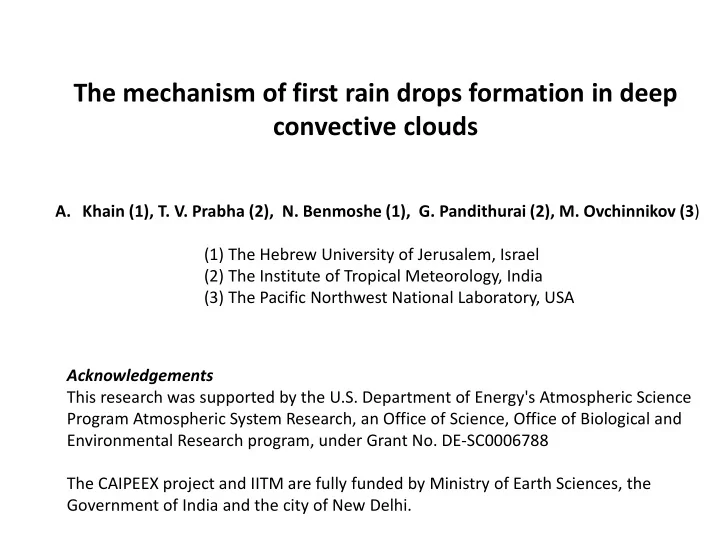

The mechanism of first rain drops formation in deep convective clouds A. Khain (1), T. V. Prabha (2), N. Benmoshe (1), G. Pandithurai (2), M. Ovchinnikov (3 ) (1) The Hebrew University of Jerusalem, Israel (2) The Institute of Tropical Meteorology, India (3) The Pacific Northwest National Laboratory, USA Acknowledgements This research was supported by the U.S. Department of Energy's Atmospheric Science Program Atmospheric System Research, an Office of Science, Office of Biological and Environmental Research program, under Grant No. DE-SC0006788 The CAIPEEX project and IITM are fully funded by Ministry of Earth Sciences, the Government of India and the city of New Delhi.
(Khain et al 2013). Height of the first rain formation as a LINEAR function of droplet concentration (Freud and Rosenfeld 2012). Observations Adiabatic parcel model SBM cloud model 3 According to the theory, in adiabatic parcel with the proportionality D ~ r N p v _ cr coefficient slightly depending on the temperature (Pinsky et al., 2013). "Why a dynamically simple adiabatic parcel model is able to reproduce the height of the first rain drops formation in a dynamically complicated non- adiabatic convective cloud involved in mixing with environment?"
The Cloud Aerosol and Precipitation Enhancement EXperiment (CAIPEEX-2010) 1) Effective radius is nearly constant 2) High adiabatic fraction corresponds to along a traverse the widest DSD 4 -3 ) LWC LWC adi LWC (gm 2 AF=0.78 0 14 r eff ( µ m) 12 10 8 12 AF=0.1 -1 ) 6 w (ms 0 -6 -12 3.4 Altitude (km) 3.2 3.0 95703 95705 95707 95709 95719 Time (UTC,Hmmss)
CAIPEEX 2009: LWC values measured at different heights in developing cumulus clouds observed : a) in premonsoon clouds developing in extremely polluted and dry atmosphere (June 16); b) transition period (June 21-) and c) monsoon clouds developing in moist and less polluted air (June -22, August 23, 24, 25).
Upper row: PDF of cloud water content at different time instances (3D SAM/SBM) . Adiabatic volumes ascending from below Bottom row: Vertical profiles of probability distribution function of effective radius at the time period of first raindrop formation. Height is measured from the surface. Observations of effective radius during a transition (pre-monsoon to monsoon) period with high aerosol concentrations is shown with black symbols.
CWC CWC CWC RWC RWC RWC a) First raindrops form in zones of maximum LWC, i.e. in undiluted zones b) In a few minutes rain is shifted to cloud edges and collect droplets. As a result, correlation between RWC and CWC becomes negative
W CWC RWC Nd a) In a few minutes after formation of first rain drops, raindrops sediment along the cloud edges in downdrafts. b) In these zones CWC and drop concentration are minimum
Conclusions : 1. Droplet size distributions in the non-diluted and slightly diluted cores are wider and contain more large droplets than in diluted volumes (non-trivial). 2. Process of raindrop formation is determined by the basic microphysical processes within ascending adiabatic volumes. This allows one to predict the height of the formation of first rain drops considering the processes of nucleation, diffusion growth and collisions in adiabatic volumes. 3. The results obtained in the study explain observational results reported by Freud and Rosenfeld (2012) according to which the height of first raindrop formation depends linearly on the droplet number concentration at cloud base.
Thank you!
Recommend
More recommend